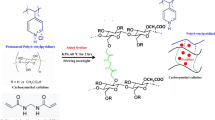Abstract
Nanocellulose from oil palm empty fruit bunch residue was synthesized using TEMPO (2,2,6,6-tetramethylpiperidine 1-oxyl)-mediated oxidation to produce TEMPO-oxidized cellulose nanofibres (TOCNs). Nanocellulose was suspended in water at a concentration of 1% (w/v) and then crosslinked with HCl, citric acid and CaCl2 to as much as 20 mmol g–1 TOCNs to form a hydrogel. The hydrogel’s water-retention capacity was analysed along with its morphological, microscopic and biodegradable properties. Hydrogels with HCl crosslinkers are known to have a higher water-retention capacity than others. After 72 h of observation, all hydrogels retained more than 80% of their water. All hydrogels were known to be completely degraded in the soil after 21 days of observation with an abundance of microbes (2.25 × 106 CFU g–1 soil). The use of crosslinkers did not seem to affect the morphology of the hydrogels microscopically, but the freeze-dried results showed that hydrogels with citric acid crosslinkers seemed to be able to maintain a 3D shape in dry conditions compared to others. This research is expected to encourage the use of agricultural residues as a source of nanocellulose that can be applied to the agricultural sector.








Similar content being viewed by others
References
Kabir S M F, Sikdar P P, Haque B, Bhuiyan M A R, Ali A and Islam M N 2018 Prog. Biomater. 7 153
Wang Y and Hsieh Y L 2004 J. Polym. Sci. Part A Polym. Chem. 42 4289
Lyu S, Chang H, Fu F, Hu L, Huang J and Wang S 2016 J. Power Sources 327 438
Hasija V, Sharma K, Kumar V, Sharma S and Sharma V 2018 Vacuum 157 458
Guilherme R M, Aouada F A, Fajardo A R, Martins A F, Paulino A T, Davi M F T et al 2015 Eur. Polym. J. 72 365
Azrina Z A Z, Beg M D H, Rosli M Y, Ramli R, Junadi N and Alam A K M M 2017 Carbohydr. Polym. 162 115
Hastuti N, Kanomata K and Kitaoka T 2018 J. Polym. Environ. 26 3698
Hastuti N, Kanomata K and Kitaoka T 2019 IOP Conf. Ser. Earth Environ. Sci. 359 1755
Isogai A, Saito T and Fukuzumi H 2011 Nanoscale 3 71
Yang K Y, Wloch D and Lee K Y 2021 RSC Adv. 11 28352
Xu H, Liu Y, Xie Y, Zhu E, Shi Z, Yang Q et al 2019 Cellulose 26 8645
Montesano F F, Parente A, Santamaria P, Sanino A and Serio F 2015 Agric. Agric. Sci. Proc. 4 451
Zhang W, Roy S, Assadpour E, Xinli C and Seid M J 2023 Adv. Colloid Interface Sci. 314 102886
Barajas R M, Wong V, Little K, Patti A F and Garnier G 2022 J. Appl. Polym. Sci. 139 51495
Cui X, Lee J J L and Chen W N 2019 Sci. Rep. 9 1
Hastuti N, Agustini L, Indrawan D A and Pari G 2021 IOP Conf. Ser. Earth Environ. Sci. 914 012057
Kasana R C, Salwan R, Dhar H, Dutt S and Gulati A 2008 Curr. Microbiol. 57 503
Saito T and Isogai A 2004 Biomacromolecules 5 1983
Abitbol T, Rivkin A, Cao Y, Nevo Y, Abraham E, Shalom T B et al 2016 Curr. Opin. Biotechnol. 39 76
Lenji M A, Haghshenasfard M, Sefti M V, Salehi M B and Moghadam A M 2017 J. Pet. Sci. Eng. 160 160
Hennink W E and van Nostrum C F 2012 Adv. Drug Deliv. Rev. 64 223
Curvello R, Raghuwanshi V S and Garnier G 2019 Adv. Colloid Interface Sci. 267 47
Lin N, Bruzesse C and Dufresne A 2012 ACS Appl. Mater. Interfaces 4 4948
Zhang N, Zang G L, Shi C, Yu H Q and Sheng G P 2016 J. Hazard. Mater. 316 11
Yoshimura T, Matsuo K and Fujioka R 2006 J. Appl. Polym. Sci. 99 3251
Wang W and Wang A 2010 Adv. Mater. Res. 96 177
Acknowledgement
This research was entirely supported by a grant from the Kurita Water and Environment Foundation, Japan, grant number 21PidO72-16. We appreciate the assistance of the Microbiology Laboratory of the Agency for Standardization and Instrumentation of Environment and Forestry, Ministry of Environment and Forestry, Republic of Indonesia, with the biodegradability test.
Author information
Authors and Affiliations
Corresponding author
Rights and permissions
About this article
Cite this article
Hastuti, N., Agustini, L., Amin, Y. et al. A novel transparent hydrogel made of nanocellulose derived from oil palm residue: evaluation of its water retention and biodegradation properties. Bull Mater Sci 46, 214 (2023). https://doi.org/10.1007/s12034-023-03065-4
Received:
Accepted:
Published:
DOI: https://doi.org/10.1007/s12034-023-03065-4




